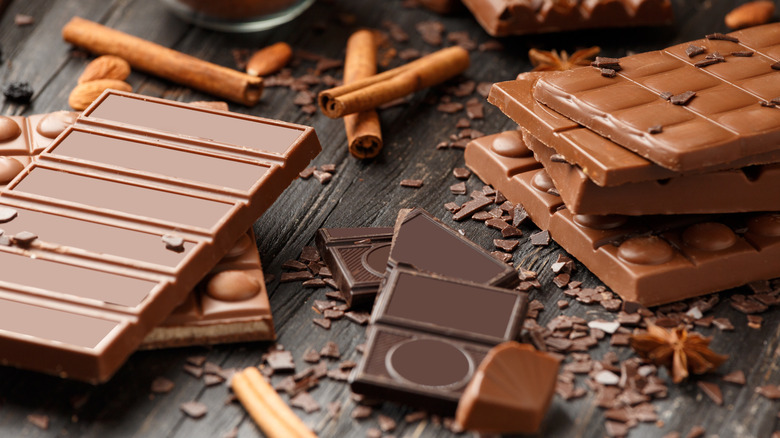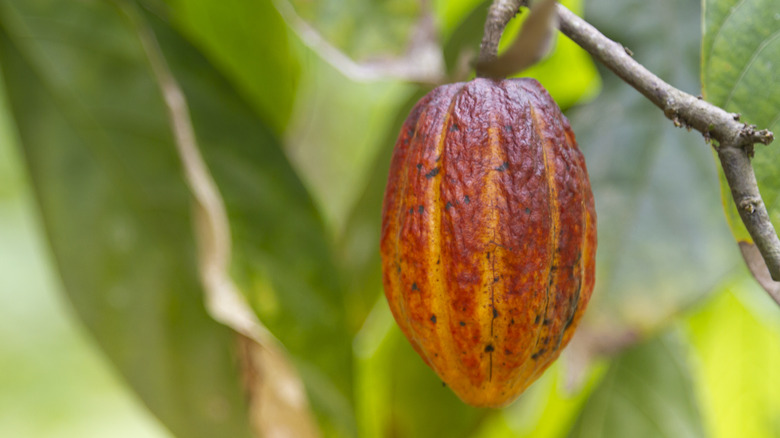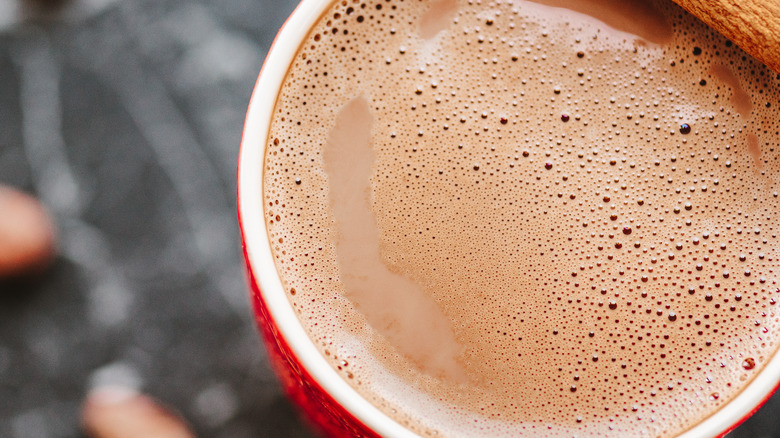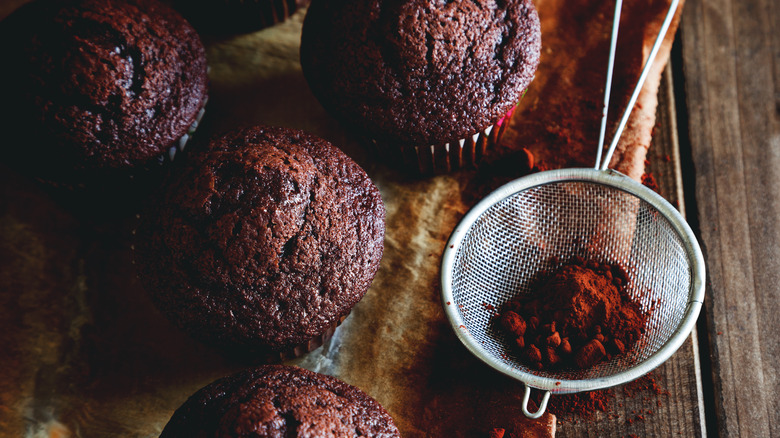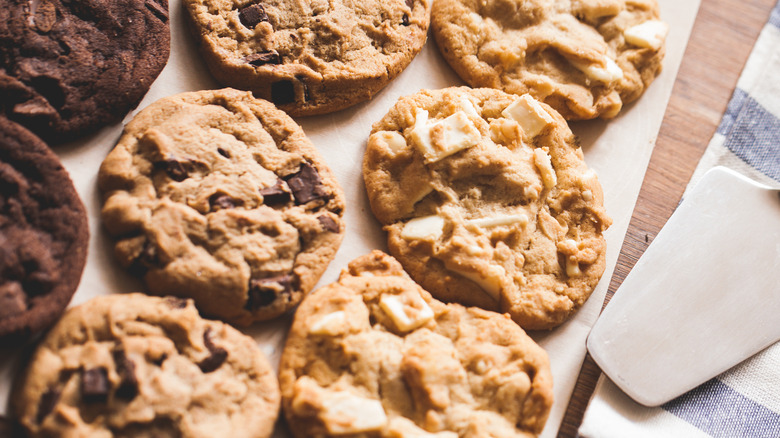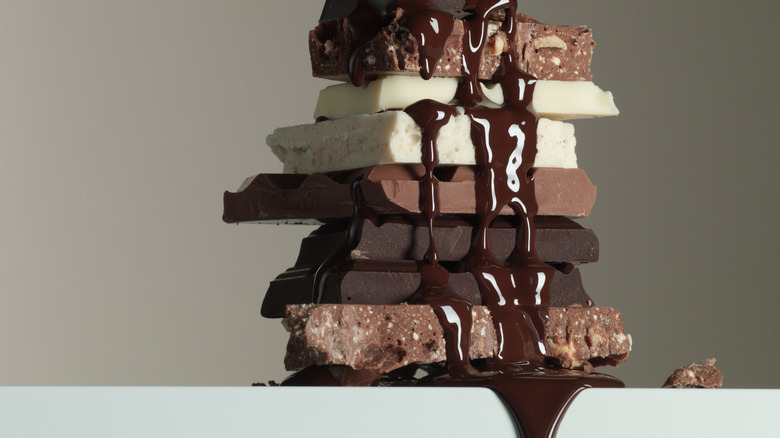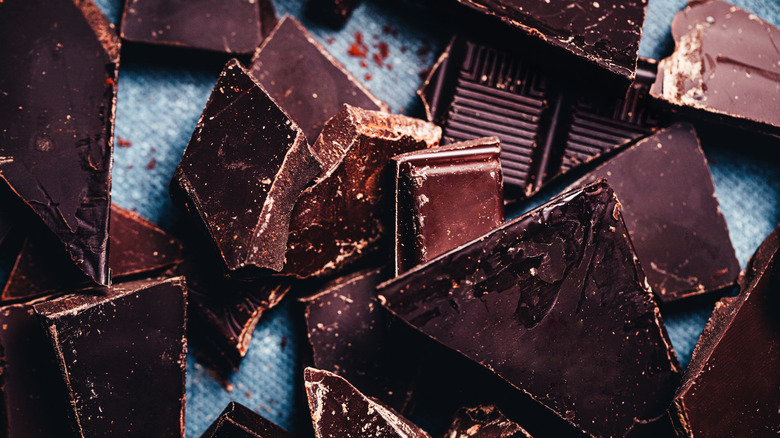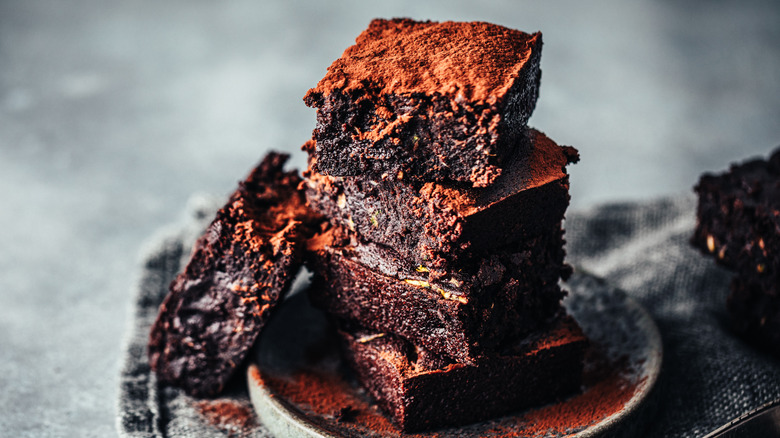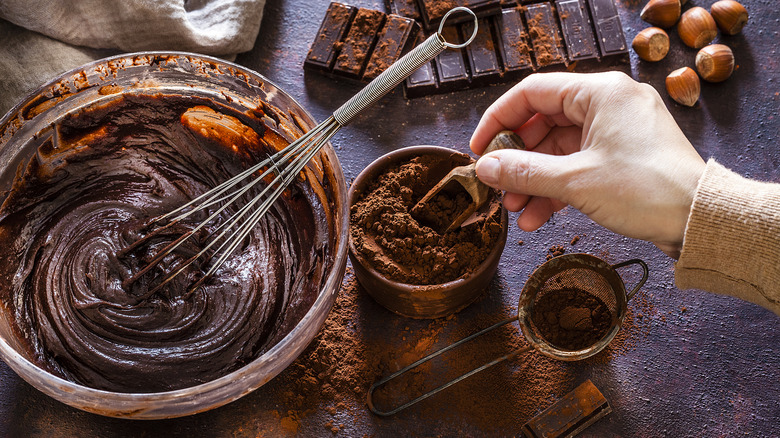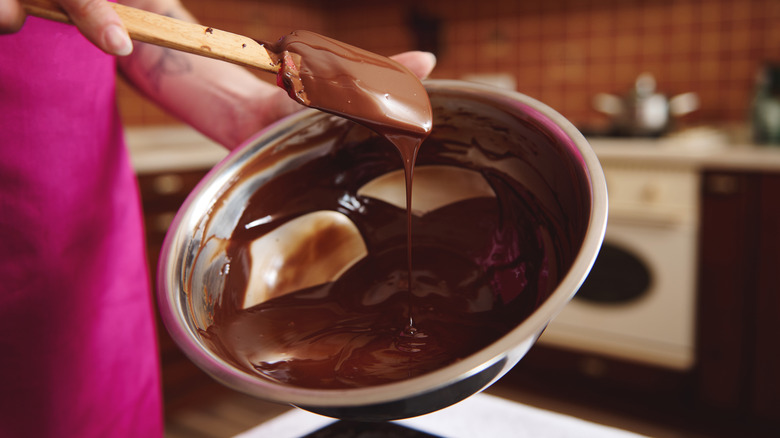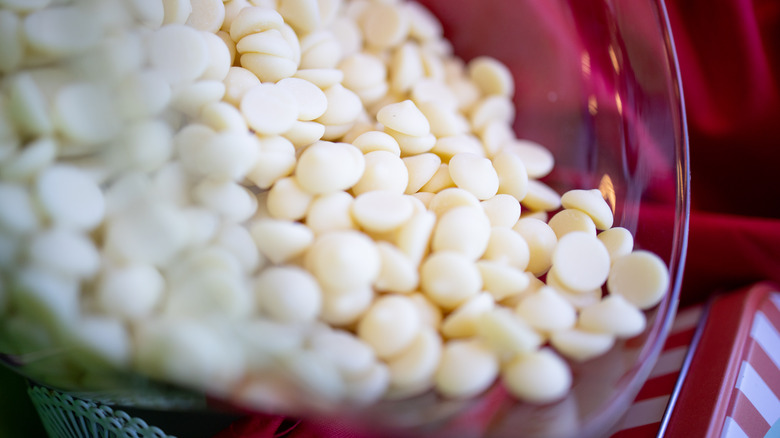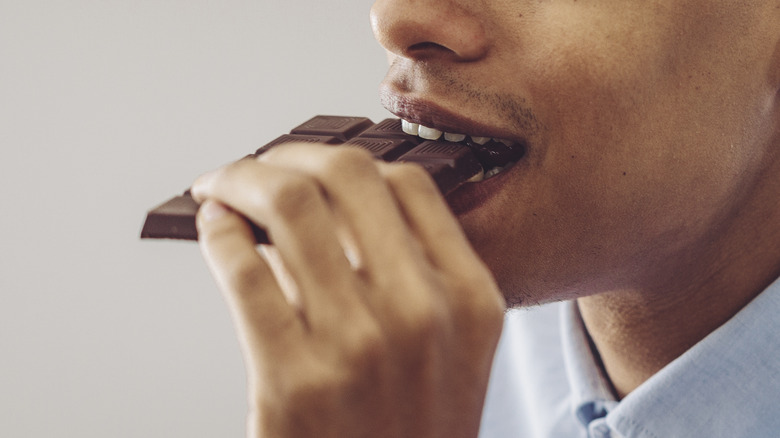Everything You Need To Know About Baking With Chocolate
Ever since it was created centuries ago, chocolate has held a hallowed place in many different cuisines. While it's primarily spotted in the pastry case, adventurous cooks will put it in everything from mole to short ribs.
If you're reading this, chances are that you know a thing or two about chocolate. But whether you've stuck to the classics (hello, brownies and chocolate chip cookies) or branched out into confectioner territory (chocolate-covered strawberries or dark chocolate salted caramels, anyone?), there's always more to learn about this rich, magical, globally beloved ingredient.
This is especially true in the world of baking. When procuring chocolate, there are so many choices that even just the process of beginning can be a bit overwhelming. From cacao percentage to chocolate-recipe pairings, there's a lot to learn. This is a primer on chocolate — as well as its provenance, uses, hot tips, and mistakes — informed by the experts. (Note that some of the tips below are specific to candy-making, but since so many baked goods call for these kinds of finishes, they're equally important to address.)
What is chocolate?
If someone told you chocolate grows on trees, how stoked would you be? Well, it does, though probably not in a form you'd recognize. (Indeed, this writer's mother-in-law once brought home one of its fruits, and it took the family 15 minutes to guess what it was.) That's because chocolate has to undergo many stages of processing to become the ingredient you can find on store shelves.
Chocolate is made from cacao (pronounced cuh-COW), so named for a word written on Mayan burial bowls that contained the substance. Today, cacao refers to chocolate in its natural state (the word even made its way into the Latin name: Theobroma cacao). The cacao tree can grow up to 30 feet in both height and canopy size and naturally inhabits tropical rainforests in Central and South America. Its flowers — and the 12-inch yellow pods that form after pollination — often grow straight on the branches and trunk, giving it an almost extraterrestrial appearance.
Each pod contains several dozen seeds or "beans" surrounded by a thick, milky substance that, while edible and slightly sweet, isn't very visually appealing. The seeds, once removed, are processed to become cocoa nibs and powder as well as cocoa butter, products used in everything from truffles to cakes to lotions. While it's best known as a sweet treat today, however, chocolate was once consumed very differently.
A brief history of chocolate
Though chocolate is now a staple of Western cooking, it didn't evolve in Europe. It's actually native to Mesoamerica, where Aztec Emperor Moctezuma II supposedly drank 50 cups of a chocolate-chili beverage blend daily. The Mayo-Chinchipe people of Ancient Ecuador are credited with the first cultivation of this now-global food, which began around 3300 B.C.E. By 1800 B.C.E., the Olmec had figured out how to brew chocolate into a hot beverage. In the 9th century C.E., the Maya used cocoa beans as currency, and archeologists have even found fakes made from clay.
Imperialist Hernán Cortés brought chocolate back to Europe, where enterprising foodies of the time transformed it into the confection we know today by adding — you guessed it — sugar. In 1879, Swiss chocolatier Rudolphe Lindt (yes, of the Lindt chocolate brand) discovered how to transform chocolate from a gritty substance into one that's smooth and melty by using a process known as conching. This involved continually heating and rolling the chocolate until it broke down.
Today, Côte d'Ivoire (or the Ivory Coast) can brag about producing the most cocoa in the world. It's followed at a distance by its neighbor Ghana, which produces only ⅓ of what the Ivory Coast pumps out annually. Other players include Nigeria, Cameroon, Indonesia, Brazil, Ecuador, Peru, Colombia, and the Dominican Republic.
What types of chocolate can you bake with?
If you're jonesing to improve your chocolate game, you first have to understand your ingredients. From cacao nibs to cocoa powder, bittersweet to semisweet chocolate chip brands, and chocolate extract to baker's chocolate, there are tons of ways to get the stuff into your baked goods and candies. If you find the baking aisle to be a bit overwhelming, though, you're not alone.
Baker's chocolate is packaged in bars that you chop for ganache or mix into cakes and brownies. The unsweetened variety tastes like you think it does, while bittersweet has a little sugar and semisweet is, well, kind of sweet. The exact cocoa and sugar content of each designation varies by brand, but you can use them interchangeably in recipes without worrying about the difference of a few percentage points. Cocoa powder also works if you want a dark chocolate effect. Meanwhile, for chocolate that you can sprinkle in a cookie or bar, opt for chocolate chips.
Then there's white chocolate. In a discussion with Chowhound, Jessica Randhawa, recipe creator behind The Forked Spoon, said, "White chocolate, which contains cocoa butter but no cocoa solids, is excellent for flavoring baking recipes like frostings and cheesecakes or can be used in a cookie recipe to add a rich, creamy texture." While the FDA once ruled that white chocolate isn't real chocolate, you can find it today in many forms, though white chocolate powder is typically flavored with other ingredients.
What's the best chocolate for baking?
Jessica Randhawa told Chowhound, "The best type of chocolate for baking really depends on the recipe and your personal taste preference. But generally, high-quality semisweet or bittersweet chocolate is the best for all-around baking. These types of chocolate have a good balance of sweetness and cocoa flavor that enhances a wide range of baked goods without overpowering other ingredients."
That said, not all chocolates work with all recipes. As discussed, white chocolate is a great go-to for frosting or cheesecake, but Randhawa added that milk chocolate is a good go-to for lighter desserts — think chocolate mousse and pudding. "Its creamy, mild flavor complements the soft, airy texture of these desserts," she said, adding, "With its robust flavor, dark chocolate is perfect for recipes that call for melted chocolate, such as ganache or chocolate sauce."
Other flavors in your recipe will also influence what kind of chocolate you choose. Rena Awada, head chef at Healthy Fitness Meals, explained to Chowhound that the milder and sweeter milk chocolate "has a higher percentage of sugar and milk solids, giving it a creamier and less intense taste than dark chocolate. This makes it great for desserts that already have a lot of other flavors and ingredients, such as chocolate chip cookies or s'mores."
How to choose chocolate
Now that you have a firm foundation of chocolate knowledge, it's time to pick your poison. Considering the number of brands on the market, though, how do you narrow them down? Jessica Randhawa recommends checking the list of ingredients first: "High-quality baking chocolate will have a short ingredient list, usually featuring cocoa mass, cocoa butter, sugar, and possibly lecithin and vanilla. Avoid chocolates with unnecessary additives or those that substitute natural ingredients with artificial ones."
Once you have your chocolate, make sure it's in a good state. You shouldn't see any whiteness (or "bloom"), which indicates exposure to warm temperatures. The chocolate should be glossy and firm and should show no signs of crumbling. If it's not in good shape, return it; your local supermarket will want to know if its ingredients aren't up to par.
Also, consider where the chocolate comes from and whether the supplier is ecologically and socially responsible. Both child labor and deforestation are issues in chocolate production, as are pesticide use and a insufficient pay for growers. If you want to choose responsibly, check out this ranking from TIME. If you can't find certain chocolate brands at a physical location, you can order most online with ease.
The importance of cocoa percentage
So, what does cocoa percentage actually mean? In a nutshell, this number indicates the amount of actual cocoa in the bar — e.g., the percentage that comes directly from the cocoa bean. You may also see this written on packages or in recipes as "cocoa mass," and for some recipes, it really matters.
"A common mistake is not paying attention to the cocoa percentage when purchasing chocolate," Rena Awada told Chowhound. "Different brands may have different percentages, which can significantly affect the flavor and sweetness of your desserts. If you really want to achieve a specific taste in your recipe, it's important to choose the right type and percentage of chocolate."
Jessica Randhawa, meanwhile, said, "For recipes with a deep, rich chocolate flavor, such as in brownies or chocolate cakes, bittersweet chocolate with a cocoa content of around 60-70% is ideal. For treats that require a smoother, sweeter taste, such as chocolate chip cookies or muffins, semisweet chocolate works wonderfully."
While the difference of a few percentage points is negligible, chocolate bars and chips range widely, from the 0% cocoa solids in white chocolate to the ultra-dark concoctions ranging in the 90-100% range. Make sure when you purchase your goods that the percentage fits your needs. Don't just trust that your "dark" chocolate is dark enough, either; check the package for cacao (and cocoa) content.
How to pair a chocolate type with your recipe
Jessica Randhawa and Rena Awada agree: The more cocoa solids chocolate has, the richer it will taste. Awada explained, "If you're looking for a rich and decadent chocolate flavor, then dark chocolate is the way to go." Its higher percentage of cocoa solids and reduced sugar bring the cocoa flavor forward on the palate. "This makes it ideal for baking," the chef said, "as the chocolate flavor will be more pronounced in your desserts." This applies to all formulas, from bars to blocks and wafers to chips.
If you want that rich taste but want to use chocolate as a dry ingredient rather than a wet one (like melted chocolate), that's exactly what cocoa powder is for. It's often one of the only flour-type dry ingredients in brownies or cakes (though leavening agents and salt are still important), and you can even pair it with almond flour to make a gluten-free soufflé.
"For pudding or custard-based desserts," Awada said in contrast, "I would recommend using milk chocolate. Its creamy and sweet flavor complements the smooth texture perfectly. It also pairs well with fruits like berries or bananas, making it a great choice for chocolate banana pudding." And, of course, white chocolate is ideal for adding a rich flavor to cream-based desserts or truffle coatings. But, as the chef cautioned, "White chocolate doesn't contain any cocoa solids, so it won't provide a strong chocolate flavor on its own."
Baking with chocolate: the main mistakes
While chocolate is pretty user-friendly, mistakes are possible. Quality is the first issue, as Jessica Randhawa said. She advised that you really must pay attention to the chocolate's quality. "Often, bakers use chocolate with additives like vegetable oils or artificial flavors," she noted, "which can affect the taste and texture of the finished dessert. It's important to choose chocolate that lists cocoa butter as one of the first ingredients rather than other fats, which ensures that you're getting a product that melts smoothly and incorporates well into recipes."
Using chocolate types interchangeably is another mistake, as Rena Awada pointed out. The chef explained, "It's always best to follow a recipe's specified type of chocolate for the best results. So, if a recipe calls for dark chocolate, don't try to substitute it with white chocolate and expect the same outcome. Paying attention to these details can make a big difference in the final taste of your desserts."
Taste isn't the only issue, either. Dark and white chocolate, for example, contain drastically different amounts of fat and sugar, both of which react differently when exposed to the crucible of the oven. The chemistry of caramelization means the sugar in white chocolate will create a different outcome than if you had used dark chocolate, while the fat in white chocolate is so much higher that you may create redundancy if your recipe calls for dark.
Tempering chocolate and why it matters
If you've ever watched a competitive baking show, chances are you've seen at least one scene about tempering chocolate. Usually, a stressed-out contestant will vigorously stir the contents of a bowl while checking a thermometer every few seconds and maintaining a steady stream of appeals to their deity of choice. It's ... hard to watch.
At home, thankfully, tempering is not the Herculean task it can be if you're on a set with a strict time budget. Even so, the process is still important; Jessica Randhawa pointed out that it's necessary "if you're using chocolate for coating or decorations. Tempering chocolate involves carefully melting and cooling it to stabilize the cocoa butter, which results in a glossy finish and a crisp snap when broken. This process is essential for professional-looking chocolates and confections."
Fortunately, tempering isn't that hard. The right way to do so is to place your chocolate over a double boiler until it's melted and reaches (but doesn't exceed) a temperature of 115 degrees Fahrenheit. Then, remove it from the heat and stir until the temperature drops below 100 degrees Fahrenheit. Once it does so, you must use it before it reaches 95 degrees Fahrenheit. As Randhawa advised, "Knowing how to temper chocolate can elevate your baking and candy-making to a professional level, ensuring your finished products taste great and look attractive."
Storing chocolate so it'll last
You don't need to worry about chocolate much in terms of expiration, though it does lose its shine and texture after a while. In general, use white and milk chocolate within eight months and dark chocolate within two years. Storing it properly will help you keep your chocolate in tip-top shape for as long as possible.
"If you're purchasing chocolate in bar or block form, it's best to store it in a cool, dry place away from direct sunlight," Rena Awada told Chowhound. "Exposure to heat and light can cause the chocolate to melt or bloom (when the cocoa butter rises to the surface). Wrap the chocolate tightly and store it in an airtight container or plastic bag. For ingredients like cocoa powder or chocolate chips, it's best to keep them in a sealed container or bag and store them at room temperature." Also, she advised, "Make sure they are stored away from any strong odors, as chocolate can easily absorb other scents."
Specifically, Jessica Randhawa said that you should keep chocolate between 60 and 70 degrees Fahrenheit, which most home cupboards can accommodate in all but the hottest months. That said, Randhawa cautioned that you shouldn't stick your cocoa products in the fridge come summer, as this can increase the chances that the chocolate will take on other odors. While this won't affect the safety of the food, the loss in quality will make the chocolate less suitable for some recipes.
Nutritional information of chocolate
So, what types of chocolate are good for you? While no doctor is going to recommend massive amounts of candy (unfortunately), it turns out that chocolate itself is actually quite healthy. It contains powerful antioxidants, specifically flavanols, which can protect your genes and help fight cancer (per a 2020 study published in Nutrients).
If you're going to eat chocolate for health reasons (no judgment here), opt for a dark variety. Though white chocolate does have some antioxidant properties, contrary to popular belief, dark chocolate has the highest amount of nutrient-containing cocoa and the lowest amount of sugar across types. Indeed, 2011 research published in Chemistry Central Journal demonstrated that dark chocolate even has more antioxidant properties than any other fruit measured, qualifying it as a "super fruit."
Bakers who want to create the healthiest goods should opt for pure cocoa powder. It contains only 12 calories per tablespoon and has no added sugar or other substances, so you can control the amount of sweetness and fat that go into your brownies, cakes, cookies, and even your fanciest cooking show-inspired creations.
